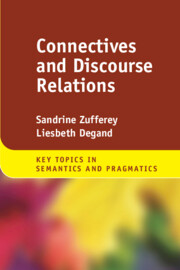Book contents
- Connectives and Discourse Relations
- Key Topics in Semantics and Pragmatics
- Connectives and Discourse Relations
- Copyright page
- Contents
- Figures
- Tables
- 1 Defining Connectives and Discourse Relations
- 2 Theoretical Models of Discourse Relations
- 3 Connectives: Meanings and Functions
- 4 Connectives between Syntax and Discourse
- 5 The Evolution of Connectives’ Meanings
- 6 Processing and Understanding Discourse Relations and Connectives
- 7 Discourse Relations and Connectives across Languages and Genres
- 8 Acquiring Connectives in a First Language
- 9 Mastering Connectives in a Second Language
- Conclusion
- Glossary
- References
- Index
- References
5 - The Evolution of Connectives’ Meanings
Published online by Cambridge University Press: 22 February 2024
- Connectives and Discourse Relations
- Key Topics in Semantics and Pragmatics
- Connectives and Discourse Relations
- Copyright page
- Contents
- Figures
- Tables
- 1 Defining Connectives and Discourse Relations
- 2 Theoretical Models of Discourse Relations
- 3 Connectives: Meanings and Functions
- 4 Connectives between Syntax and Discourse
- 5 The Evolution of Connectives’ Meanings
- 6 Processing and Understanding Discourse Relations and Connectives
- 7 Discourse Relations and Connectives across Languages and Genres
- 8 Acquiring Connectives in a First Language
- 9 Mastering Connectives in a Second Language
- Conclusion
- Glossary
- References
- Index
- References
Summary
In this chapter, we first sketch a number of assumptions underlying diachronic research in order to understand how researchers sketch the emergence of discourse connectives (and discourse markers) in language. We then review the discussion about the theoretical framework underlying the diachronic evolution of discourse connectives, that is, in which conceptual terms this linguistic process is best accounted for, grammaticalization or pragmaticalization. We then turn to a general description of the evolution from clause combining strategies to coordinating and subordinating connectives. Different case studies are presented in order to illustrate typical and less typical cases of language change in the area of connectives: the semantic evolution from temporal meaning to concessive meaning of French cependant (‘yet’), the peculiar semantic evolution from cause to contrast of Italian però (‘but’) (5.3.2), and a diachronic account of the synchronic polysemy of French alors.
- Type
- Chapter
- Information
- Connectives and Discourse Relations , pp. 92 - 115Publisher: Cambridge University PressPrint publication year: 2024

